Abstract
Background:
It is unknown which proctological position is most embarrassing to patients.
Methods:
Individuals consecutively referred to our outpatient clinic in order to determine the causes of anal and/or abdominal complaints were randomized to complete an unvalidated six-item questionnaire which asked for their preferred proctologic positioning either before or after a proctological examination in knee–chest position followed by inspection of the anal verge, digital examination of the anal canal, and anoscopy. A third group of patients referred for gastroscopy was asked to complete the questionnaire before being gastroscoped.
Results:
One hundred seventy-eight individuals of both genders aged 16–80 years who consecutively entered our outpatient clinic were enrolled. One third in each group had never experienced any of the offered medical positionings. Most patients favored the Sims’ position if they had the choice. Randomized patients favored the knee–chest position more after experiencing it compared to those without experience (P < 0.03). Patients favored the positions they had recently experienced irrespective of the other positions offered in the questionnaire (P < 0.05). Individual answers to the question ‘which position do you find most embarrassing?’ did not depend on sex or age at first examination or when their last examination was performed. The majority of patients (55.2%–71.4%) held that no type of proctological positioning was most embarrassing to them.
Conclusions:
The medical profession is authorized to use the proctological positioning that allows the most reliable anal diagnoses.
Introduction
Positioning of patients for proctological assessment when anal bleeding, itch, or pain occurs may not belong to the major fields of interest of medical doctors but it might be essential for the reliability of diagnosis.Citation1,Citation2 The left lateral Sims’ position is said to be well tolerated, especially by aged or debilitated patients.Citation3 Certainly it is more comfortable than the knee–chest position. It is said that patients seem to prefer the recumbent position to the knee–chest position.Citation4 Others found that the lithotomy position seems to be less tolerated.Citation5 Whilst diagnoses might depend on positioning,Citation1,Citation2 doctors argue that the patient’s sense of shame is violated in other than the left lateral Sims’ position.Citation4,Citation5 In fact doctors might be biased regarding positioning of patients for proctological examination and some may even conceal their own preferences. We asked patients with and without anal complaints what they think about positioning for a proctological examination.
Methods
Patients
Individuals who were referred by general practitioners, physicians, gynecologists or urologists in order to determine the causes of anal and/or abdominal complaints were asked to complete an unvalidated six-item questionnaire with closed-ended questions, which sought information on their preferred medical positioning for proctological examination (). Patients were randomized to complete the questionnaire either before (Group A, N = 60) or after (Group B, N = 60) a proctological examination in knee–chest position with their body bent forward followed by inspection of the anal verge, digital examination of the anal canal, and anoscopy. A third group (Group C, N = 60) of patients referred for gastroscopy, and therefore not expecting and not having a proctological examination was asked to complete the questionnaire before being gastroscoped. We compared the three groups for their demographic items and their answers to the questionnaire.
Table 1 Patients’ questionnaire with given answers (Please mark items as apply)
Literature search
We searched PubMed from April 2006 to July 2008 and found 5,801 entries for “positioning of patients”. We checked the first 1,000 titles and did not find one paper concerned with proctology. For other medical specialities, the numbers were: orthopedics (15%), anesthesia (14%), neurosurgery (11%), otorhinolaryngology (9%), cardiovascular surgery (9%), intensive care (8%), radiology (8%), gastroenterology (5%), radiotherapy (4%), physiotherapy (4%), ophthalmology (3%), urology (3%), dentology (2%), cancer research (1%), vascular surgery (1%), laparoscopy (1%), gynecology (1%), and rehabilitation medicine (1%). One hundred seventy-two entries were found for “patients’ positioning”, none for “proctological positioning”, but 12 for “proctological assessment”. None of these were concerned with positioning of patients for proctological examination.
Statistics
For interval-level variables one-way analysis of variance with 95% confidence intervals and the Student–Newman–Keuls procedure as post hoc test was used for detecting homogeneity subsets. For categorical-level variables, contingency tables were analyzed with the corresponding Pearson chi-squared statistic. For all analyses a significance-level of alpha = 0.05 was used. Data were analyzed using SPSS software (version 15; SPSS Inc., Chicago, IL, USA).
Ethical guidelines
This study has been conducted in accordance with the Declaration of Helsinki (1964) with the understanding and the consent of the patients. Each patient gave written consent to participate in the study, and to take photos of their anal lesions to be presented in scientific medical journals or for educational purposes with medical students and medical doctors.
Results
Patients
A total of 178 individuals of both genders aged 16–80 years who consecutively entered our outpatient clinic from July 11th, 2005, to September 30th, 2005 were enrolled. The dates of two individuals were fed twice into the PC by mistake and therefore taken out. Thus only 178 instead of 180 individuals have been evaluated ().
Table 2 Comparison of the demographic data of the three groups of patients and results of the questionnaire
The three groups of patients are homogenous concerning demographic data with minder differences for age and nationality. The majority of patients had gained experience with the Sims’ and the lithotomy position at ages 5 to 50 years, and would favor them most if they could choose. About one third in each of the three groups of individuals had never experienced any of the offered medical positionings ().
Randomized patients favored the knee–chest position with their body bent forward more after having experienced this position (Group B) compared to those without experience (Group A) with 17 of 57 patients (29.8%) vs six of 52 patients (11.5%) (P < 0.03; Fisher’s exact test). Preference for this position was minimal in the gastroscopy group, group C ().
All three groups of patients favored the positions they had recently experienced irrespective of the other positions offered in the questionnaire (P < 0.05). Women predominantly experienced the lithotomy position (P < 0.01). Individual answers to the question ‘which position do you find most embarrassing?’ did not depend on sex or age at first examination or on how recently their last examination was performed. But 13 of 30 women (43.3%) and four of 28 men (14.3%) in group C found the lithotomy position with lifted legs embarrassing (P < 0.01).
With the exception of the lithotomy position with lifted legs, patients of all three groups with no personal experience of any of the offered medical positionings in the questionnaire did not differ in their answers from patients with experience of them. The lithotomy position with lifted legs was found embarrassing by 40.9% of group A patients, but by only 15.4% of group B patients (P < 0.034). More group A men were embarrassed by the lithotomy position compared with group A women (P < 0.012). The figures for group A women compared to group B women were 25% vs 21.7%, respectively. The knee–chest position with body bent forward was found to be embarrassing by 31.6% of group A patients but only 5.1% of group B (P < 0.012).
Discussion
Patient positioning during proctologic assessment is important for patients and doctors. We were unable to find articles where patients’ wishes about positioning for proctological examinations have been evaluated. Doctors may unwittingly hide their own preferences behind alleged patients’ wishes.Citation3–Citation5
The most striking result of our investigation is that more than half of patients (55.2%–71.4%) expecting or having had a proctological examination as well as those individuals who were uninvolved in it (gastroscopy-group) held that no type of proctological positioning is most embarrassing to them. Even though the majority of individuals would favor Sims’ position if they had the choice (), they give freedom to their doctors to choose that position which seems most suitable to get reliable diagnoses. Hence proctological positioning should not depend on doctors’ convenience or customary rules. The key point should be the best position for the most reliable diagnoses of anal complaints.
This may differ according to the position used. The left lateral Sims’ position is more comfortable and patients achieve it easily and quickly by themselves; thus the investigating physician saves time by not having to position the patient.Citation3–Citation5 A fundamental drawback of the knee–chest position might be that hemorrhoids could be found less frequently because of the sloping position of the patient; the large intestine may be pulled down towards the patients’ head so that the hemorrhoids may be unable to protrude.Citation1,Citation2 However, it may provide a better field of view on anal and perianal surface than broadly used left lateral Sims’ position, as the buttocks fall to each side, and finger tips of both hands of the investigator are free for gentle eversion of the anal skin, which may assist in more differentiated, and therefore more reliable diagnoses in good lightingCitation1,Citation6 (–).
Figure 1a The 42-year-old man is in knee–chest position, head left. He complained of anal itch, bleeding, and pain. Hairs are seen at the buttocks in the uneverted anal region.
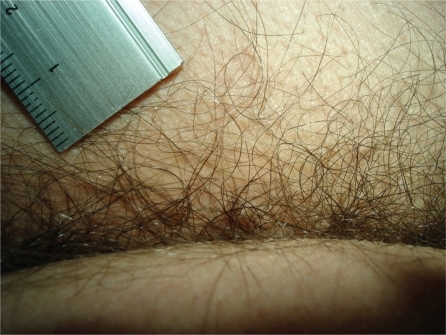
Figure 1b The same patient after gentle eversion of the anal skin by the finger tips of both hands of the investigator. A reddened and whitish anal skin surrounded by hairs is found. The anal skin shows longitudinal superficial splits (perianal dermatitis/anitis/pruritus ani).
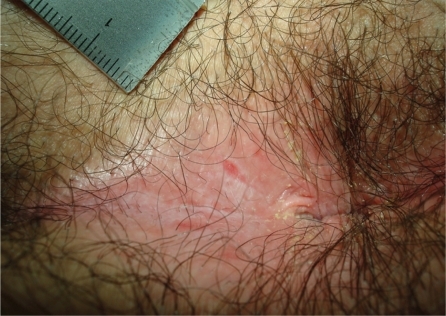
Figure 1c Looking at anal verge of the same patient after strong eversion of the anal skin two chronic anal fissures (posterior and anterior) appear surrounded by a pale skin covered with partially bleeding superficial longitudinal splits.
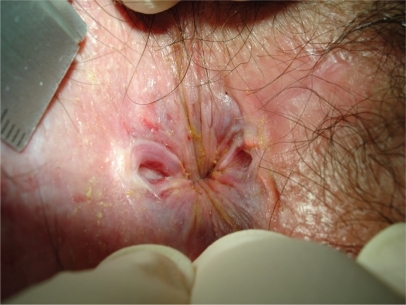
Figure 2a The 54-year-old woman is in knee–chest position, head left. She complained of anal bleeding, and pain. The anal verge is surrounded by anal tags without signs of inflammation such as edema or a reddened skin.
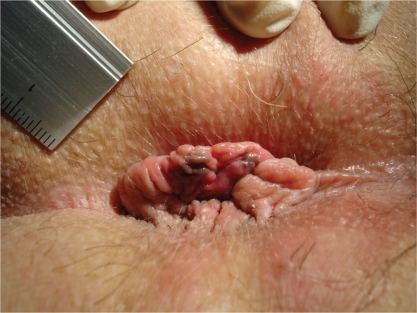
Figure 2b By gentle eversion of the anal tags by the finger tips of both hands of the investigator the dentate line appears with bright red columnar epithelium distally (hemorrhoids). Proximal the dentate line a small superficial split 3 mm to 4 mm in length within the squamous epithelium is seen (superficial fissure).
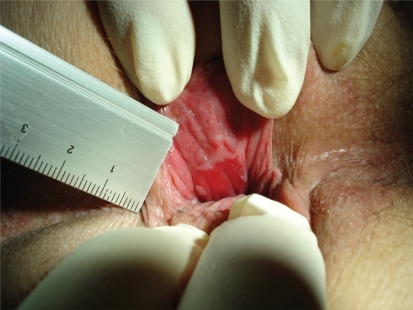
Figure 3a With gentle eversion (see the finger tips of the investigator) nothing striking is seen at the anal verge of this 23-year-old man with anal itch, pain, and bleeding when brought into the knee–chest position with his head left.
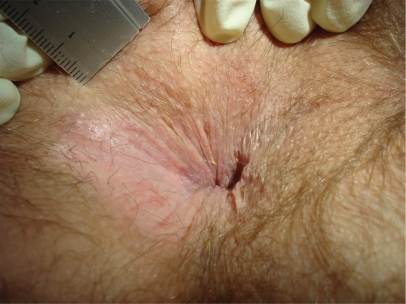
Figure 3b But if the anal skin was everted by use of the finger tips of both hands, numerous red superficial round and longitudinal gaps within the squamous epithelium proximal the dentate line are found (pruritus ani/anitis/perianal dermatitis).
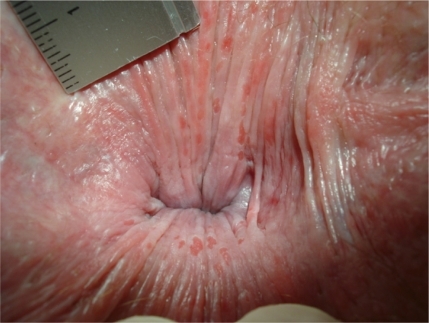
Figure 4a This 32-year-old man is in knee–chest position with his head left. He complained of anal itch at times combined with anal bleeding and pain. We see an inconspicuous anal verge covered with hairs.
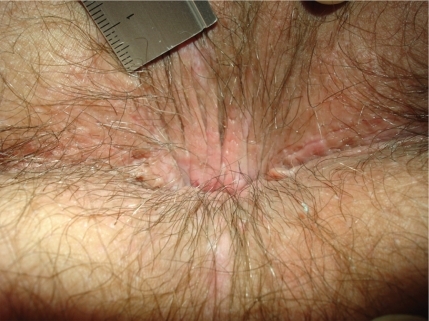
Figure 4b Only by eversion of the anal skin by use of the finger tips of both hands, a whitish anal skin appears distal to the dentate line. It is covered with longitudinal superficial red splits and spots (pruritus ani/anitis/perianal dermatitis).

By use of such methodology, concomitant anal findings like skin tags or a hairy anus were found in 50.6% of patients with benign anal diseases such as hemorrhoids or pruritus ani.Citation2 Moreover concomitant anal findings were shown to play a role in the pathogenesis of benign anal diseases when patients with and without concomitant anal findings and benign anal diseases were compared (P < 0.01).Citation2 Since sensitivity, specificity, and the predictive value of anal diagnoses in different proctological positions are unknown to find out causes of anal bleeding, itch, or pain randomized clinical trials are needed to find out optimal proctologic positions for both: concomitant anal findings and benign anal diseases. Patients’ answers to our questionnaire authorize doctors to do so since none of different proctological positionings are most embarrassing to them.
Disclosures
HR had the idea. All authors contributed to the design of the study. OG was responsible for literature research. OG and HR saw the patients and asked them to complete the questionnaire. Findings were ticked into a PC study documentation sheet after medical assessment of each patient. Results were discussed with all authors. YH was responsible for statistical evaluations. OG wrote the first drafts which were revised by all authors. HR wrote the final drafts. Prof. Ken Newton, edited the final draft of the manuscript. There are no conflicts of interests. The study was sponsored by the authors themselves. There were no financial or nonfinancial competing interests (political, personal, religious, ideological, academic, intellectual, commercial or any other). The authors disclose no funding sources including the writing of the manuscript and the decision to submit it for publication, data collection, analysis, or interpretation, study design, patient recruitment or any aspect pertinent to the study. None of us has been paid to write the article. All authors had full access to all the data in the study and had final responsibility for the decision to submit for publication.
References
- RohdeHDiagnostic errorsLancet2000356127811072979
- KuehnHGGebbenslebenOHilgerYRohdeHRelationship between anal symptoms and anal findingsInt J Med Sci20096778419277253
- SchrockTRExamination of the anorectum and diseases of anorectumSleisingerMHFordtranJSGastrointestinal Disease25th editionPhiladelphia, PAW. B. Saunders199314941516
- NagleDRolandelliRHPrimary care office management of perianal and anal diseasesPrimary Care1996236096208888347
- LewisTHCormanMLPragerEDRobertsonWGLong-term results of open and closed sphincterotomy for anal fissureDis Colon Rectum1988313683713366036
- Lockhart-MummeryHENon-veneral lesions of the anal regionBrit J Vener Dis196339151713931201